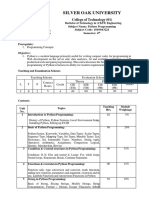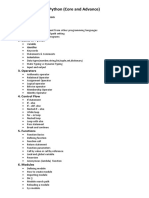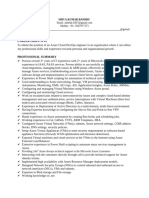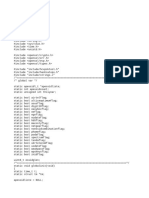0 ratings0% found this document useful (0 votes)
5 viewsPython Learning Challenge Series
Uploaded by
vabaca3148Copyright
© © All Rights Reserved
We take content rights seriously. If you suspect this is your content, claim it here.
Available Formats
Download as PDF, TXT or read online on Scribd
0 ratings0% found this document useful (0 votes)
5 viewsPython Learning Challenge Series
Uploaded by
vabaca3148Copyright
© © All Rights Reserved
We take content rights seriously. If you suspect this is your content, claim it here.
Available Formats
Download as PDF, TXT or read online on Scribd
You are on page 1/ 4
Python Learning Challenge Series
Phase 1: Python Basics
1. Introduction to Python: Why learn Python?
2. Installing Python and Setting Up IDEs: Using VS Code, PyCharm, etc.
3. Hello World Program: Your first Python code.
4. Python Syntax and Indentation: The basics of writing Python code.
5. Variables and Data Types: Strings, integers, floats, and booleans.
6. Taking User Input: Using the input() function.
7. Basic Arithmetic Operations: Addition, subtraction, multiplication, and division.
8. Comments in Python: Single-line and multi-line comments.
9. String Manipulation: Slicing, concatenation, and string methods.
10. Control Flow - if Statements: Basic conditional logic.
11. Control Flow - if-elif-else: Handling multiple conditions.
12. Loops - for Loops: Iterating through ranges and lists.
13. Loops - while Loops: Conditional iteration.
14. break and continue: Controlling loop execution.
15. Functions: Writing and calling functions.
16. Function Arguments: Positional and keyword arguments.
17. Return Statements: Returning values from functions.
Phase 2: Intermediate Python
18. Lists: Creating, accessing, and manipulating lists.
19. List Comprehensions: A Pythonic way to create lists.
20. Dictionaries: Key-value pairs in Python.
21. Dictionary Methods: Accessing and modifying dictionaries.
22. Tuples: Immutable data structures.
23. Sets: Unique elements and set operations.
24. Understanding Mutable and Immutable Objects.
25. Error Handling - try-except: Handling exceptions gracefully.
26. Error Handling - finally and else.
27. File Handling - Reading Files: Using open() and read().
28. File Handling - Writing Files: Writing data to files.
29. File Handling - Using Context Managers: with open() syntax.
30. Python Modules: Importing and using modules.
31. Working with datetime Module.
32. Working with math Module.
33. Working with random Module.
34. Introduction to Object-Oriented Programming (OOP).
35. Classes and Objects: Creating and using classes.
36. Constructors in Python: Using __init__().
37. Instance and Class Variables: Differences and usage.
Phase 3: Advanced Python
38. Inheritance in Python: Single and multiple inheritance.
39. Polymorphism: Method overriding and operator overloading.
40. Abstract Classes and Interfaces.
41. Decorators: Function and class decorators.
42. Generators: Using yield for generating values.
43. Iterators: Understanding and creating iterators.
44. Lambda Functions: Anonymous functions in Python.
45. Map, Filter, and Reduce: Functional programming tools.
46. Understanding Python's global and nonlocal Keywords.
47. List vs Tuple vs Dictionary vs Set: Key differences.
48. Working with JSON: Reading and writing JSON files.
49. Regular Expressions (re Module).
50. Working with APIs: Using requests module.
51. Understanding Python's os Module: File and directory operations.
52. Understanding Python's sys Module.
53. Multithreading in Python.
54. Multiprocessing in Python.
Phase 4: Python for Real-World Applications
55. Web Scraping with BeautifulSoup.
56. Data Analysis with Pandas.
57. Data Visualization with Matplotlib and Seaborn.
58. Automating Tasks with Python: Using pyautogui.
59. Building a CLI Tool.
60. Introduction to Flask: Your first web app.
61. Introduction to Django: Creating a simple project.
62. Building a REST API with Flask.
63. Basic Game Development with Pygame.
64. GUI Development with Tkinter.
65. Working with SQLite Database in Python.
Phase 5: Advanced Python Applications
66. Machine Learning with Python: Introduction to scikit-learn.
67. Deep Learning with TensorFlow/Keras.
68. Creating a Chatbot with Python.
69. Cryptography with Python.
70. Blockchain Basics with Python.
71. Python for Ethical Hacking.
72. Web Automation with Selenium.
73. Building a Python Package: Making it pip-installable.
74. Deploying Python Applications: Using Docker and cloud platforms.
You might also like
- Sci 3265 Computer Science II Outline 2024 SeriesNo ratings yetSci 3265 Computer Science II Outline 2024 Series3 pages
- A Comprehensive Guide to Learning Python for Year 10 StudentsNo ratings yetA Comprehensive Guide to Learning Python for Year 10 Students4 pages
- AD-141 Introduction To Python Programming: Duration: 4 DaysNo ratings yetAD-141 Introduction To Python Programming: Duration: 4 Days3 pages
- Python Programming Basic Python: 1. Introduction To Python 5. LoopingNo ratings yetPython Programming Basic Python: 1. Introduction To Python 5. Looping3 pages
- 2024-07-13T16-12-31.328Z-Python Road MapNo ratings yet2024-07-13T16-12-31.328Z-Python Road Map6 pages
- Python Programming Language/ Core Python (Video Course Curriculum)No ratings yetPython Programming Language/ Core Python (Video Course Curriculum)3 pages
- Assignment: Programs, Elements of Python, Type Conversion. Precedence, Boolean ExpressionNo ratings yetAssignment: Programs, Elements of Python, Type Conversion. Precedence, Boolean Expression2 pages
- Beyond the Basic Stuff with Python: Best Practices for Writing Clean CodeFrom EverandBeyond the Basic Stuff with Python: Best Practices for Writing Clean CodeNo ratings yet
- Mastering Python: A Comprehensive Crash Course for BeginnersFrom EverandMastering Python: A Comprehensive Crash Course for BeginnersNo ratings yet
- Sample20Paper20120Class20XI20Annual20Exam20CS PDFNo ratings yetSample20Paper20120Class20XI20Annual20Exam20CS PDF7 pages
- Hilt Testing Guide - Android DevelopersNo ratings yetHilt Testing Guide - Android Developers12 pages
- ZAID SHABBIR Computer and Robotic ScientistNo ratings yetZAID SHABBIR Computer and Robotic Scientist1 page
- Installation - GR-GSM - Open Source Mobile CommunicationsNo ratings yetInstallation - GR-GSM - Open Source Mobile Communications5 pages
- Concurrency Freaks - Interrupt Handler in C11 With AtomicsNo ratings yetConcurrency Freaks - Interrupt Handler in C11 With Atomics4 pages
- Dependency Graph and Bernstein ConditionsNo ratings yetDependency Graph and Bernstein Conditions39 pages
- Activity Solutions For Web Development With DjangoNo ratings yetActivity Solutions For Web Development With Django120 pages

























































































